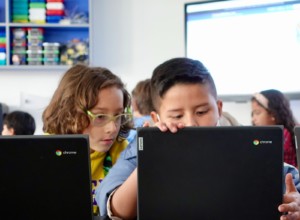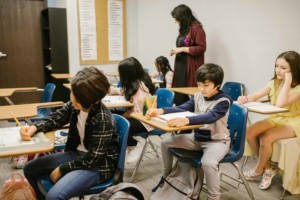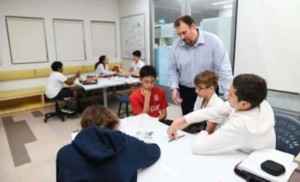Middle Grade Humanities: Going Beyond the English Class

The middle grades serve as important years for students to immerse themselves in reading and writing across content areas. Schools are increasingly finding ways to create opportunities for students to write and read in content areas that go beyond the English class.
David Ruff joined us for a Google Hangout to chat a little bit about blended, integrated project-based humanities. David is executive director of Great Schools Partnership and leader of the New England Secondary School Consortium (NESSC), a network of high schools in Connecticut, Maine, New Hampshire, Rhode Island, and Vermont. The network has established a framework with standards that are supported by performance indicators. Schools within the NESSC are breaking through what used to be traditional content areas and are re-tooling the curriculum to ensure the learning is more integrated. As David mentions in the chat, learning in the “real world” is much less isolated and more immersive than in traditional silos or content areas. He wonders, why we are teaching content areas in such isolation?
Last week, David headed up a “design thinking” conference with educators from the NESSC, and David shared with us some of the new thinking around ways to approach teaching Humanities in the middle grades.
Here are some key ways of thinking about an integrated approach to middle school humanities, and the importance of going beyond the English class.
Competency-based Learning. The Great Schools Partnership, the NESSC, and other organizations such as Competency Works place an emphasis on competency-based, or proficiency-based, learning. The NESSC uses a seven part definition of proficiency-based learning:
- Students advance upon demonstration of mastery of content, 21st century skills, and dispositions that prepare them for college and careers;
- Learning standards are explicit, understood by students, and measurable;
- Assessments–formative, interim, and summative–measure and promote learning;
- Demonstration of learning uses a variety of assessment methods including in-depth performance assessments that expect application of learning;
- Instruction is personal, flexible, and adaptable to students’ needs–both initially and as required by ongoing student learning;
- Students both direct and lead their learning even as they learn from and with others–both within and outside of schools; and
- Grading is used as a form of communication for students, parents, and teachers–not control or punishment.
By creating and having larger, broader and more thoughtful standards, students can integrate their work across subject areas and can think through big and more complex ideas. The Nellie Mae Education Foundation also has competency-based learning as one of its 4 key tenants for learning and believes that true mastery should be demonstrated by students rather than moving students forward based on the outdated “seat time” model.
Leadership is Key. High quality instructional leadership encourages prioritization of ensuring that Humanities are fully integrated across content areas. We know that for any initiatives to be successful in school, we need high quality school leadership, which includes principals and teacher-leaders. Instructional strategies can expand the learning for students, create opportunities for integration, and include a more holistic approach to learning.
Writing Across the Curriculum. Quality writing is really everybody’s job, not just the responsibility of the English teacher. It’s important for teachers to share and look at student work together. There are many protocols in place that educators can use when reviewing student work together, and through these discussions, teachers can learn more about what high quality looks like and strategies for providing the most effective forms of feedback to students.
If you are a teacher who has ever been frustrated by the hours you spent giving a student feedback on his or her writing only to find the piece of paper in the trash, learning the most effective ways to give students’ feedback on their writing (and ensuring they act on that feedback) is critical. These days, many teachers are turning to cloud-based technology, such as using Google Drive or other digital portfolio options with students, so that students can’t “lose” drafts of writing. Students can, however, mark a piece of feedback as “resolved,” without making additional changes. Educators could and should encourage students to save multiple drafts of their writing to demonstrate their improvement. These drafts all show evidence of an effective writing process which could be showed at a student-led conference or student exhibition of their learning.
Technology Helps. Technology is a huge assist to improving writing and promoting integration of content. As David Ruff said in the Google Hangout, “I don’t think that you can talk about personalizing the learning without technology. That is both in terms of instructional and learning strategies and the management of each student’s individualized learning plans.”
A high degree of personalization will encourage the engagement of students in expanding the writing across the curriculum, and ensure that middle school Humanities goes beyond the English class. In the real world, we read and write in all disciplines. Taking writing beyond the English class showcases how writing is used in real world settings.
This blog is brought to you by The Nellie Mae Education Foundation as part of a series on blended humanities. For more stayed tuned for the Getting Smart on Blending Middle Grade Humanities bundle and see the other posts in this series:
- Using Blended Tools to Maximize Instructional Time
- Writing Across the Curriculum With The Literacy Design Collaborative
- Collaborative Approach to Literacy
- Deeper Project Based Learning
- Big History: An Organizing Principle for a Compelling Class, Block or School






Renmandfx
Interesting. Even more is that once again the arts are left out.
I dare anyone to study THEATRE ARTS and NOT integrate every area of learning, both academic and practical.
Theatre, being a mirror of the world, uses English (analysis), History (historical context), Science (all those special effects, electricity, makeup, set construction, etc), Math (accounting and all the math needed to "make things"), Computer Science (computer controlled sound boards, light boards, intelligent lights, sets, CAD, CNC, etc.), Dance, Music, Visual Art (2 & 3-D), Film and TV technology, Engineering (sets, lights, stages, special effects, etc.), Skilled Trades (construction, metal fabrication (it's way more than welding!), fashion technology (way more than mere sewing), plumbing (well you want rain on that set now don't you as well as practical kitchens and other effects), brick and cement work (sets), and........... the list is SO long. It is SO much more than just some actors on a stage (who, save for the tech, would be in their skivvies, in the dark, with not set, unheard, and with no audience).
But no, the arts are pushed to the side as being frills.
Here's a little thought problem for you:
At the end of Act I of Wicked, Elphaba sings the closing number "Defying Gravity." Naturally, we want her to defy gravity and fly high above the stage.
BUT -- because we want the show to look the same regardless venue, you can NOT fly her by the traditional method using wires.
She needs to go from stage level to about 40 feet high, moving in a straight up vertical line in just about 5 seconds.
How do you do that without letting the audience seen the means at all, while allowing the chorus to surround her singing and dancing, make it totally safe for the actress, repeatable 8 times a week, and portable enough to toss in the back of a semi and take on tour?
You want STEM and project based learning -- the go full STEAM (STEM + the ARTS) and mount a show, design a theme park attraction, design and film a movie or TV show. I guarantee you the students will learn multiple skills that will be applicable to many other professions.
Replies
Bonnie Lathram
Thanks so much for your reply. We love and value the theater and the arts. We look forward to doing some more blog posts that speak specifically to the importance of arts in STEAM (as you mention).